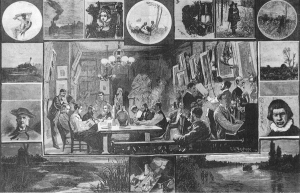
Charles S. Reinhart (1844-1896) Drawn by|The Tile Club at Work|Illustration for Harper's Weekly v. XXIV no. 1205 (January 21, 1880): 72-3|wood engraving
Stories about the life of artists and views into artists’ studios were frequently published in American newspapers and magazines throughout the last quarter of the 19th century. Not only were artists and their activities a bit bohemian and therefore interesting, but visiting studios and going to gallery exhibitions were commonplace activities for people interested in culture from both the middle and upper classes. One artist studio and creative group that caught the public’s attention was a small art club in New York City called The Tile Club.
Sparked by the interest in the decorative wares (pottery, glass, textiles, etc.) featured in displays at the 1876 Centennial celebration in Philadelphia, The Tile Club was informally formed in the fall of 1877 with the members meeting weekly in each other’s studios to discuss matters of art and to create their paintings in a decorative form as decorated tiles. Without prior experience in decorating tiles, the weekly meetings encourage creative experimentation in quick-drying inks on pre-made blank tiles which after decoration could be fired in a studio kiln.
In the summer of 1878 members of The Tile Club made their first group trip out to Long Island. Upon their return a chronicle of that trip was sold to Scribner’s Monthly Magazine and published the following February as “The Tile Club at Play.” Their 1879 summer trip on a barge traveling up the Hudson River was recounted in a March 1880 Scribner’s article, “The Tile Club Afloat.” Just before the second Scribner’s publication, Harper’s Weekly published an overview on the club in their January 31, 1880 issue. Club member Charles S. Reinhart provided the drawing (seen above) that would be turned into a wood engraving illustration to accompany the article. It would not be until the late 1890s that publishers would use half-tone photos of drawings and paintings for their illustrations.
Created as a double-page spread, the illustration is composed of a central image of Tile Club activity in the studio of the fashionable photographer and club member, Napoleon Sarony. Like other artist’s studios, the room is filled with paintings, statuary, and tall windows. In this genial setting some members provide a little concert (seen at the right) to accompany the artists’ creative endeavors. At the left in the studio one of the gentlemen seated around the table wearing a fez and sporting an outrageous mustache is a portrait of Sarony. The framework surrounding the central image is constructed of images copied from various members’ tile creations. Tile Club members signed their work using their club sobriquets. Reinhart was known as Sirius and Sarony was Hawk.
Over the short life of The Tile Club (1877-1887) there were a total of thirty-four members, but only twelve full members at any one time. Six of the thirty-four were honorary members who were mostly musicians and writers. Eight of the twenty-eight full members were artists who worked as illustrators, including four of the founding eleven members. During the last quarter of the nineteenth century artists who turned to illustration to earn their living were still considered to be part of the mainstream of the art world.
August 24, 2009
by Joyce K. Schiller, Curator, Rockwell Center for American Visual Studies
Norman Rockwell Museum






